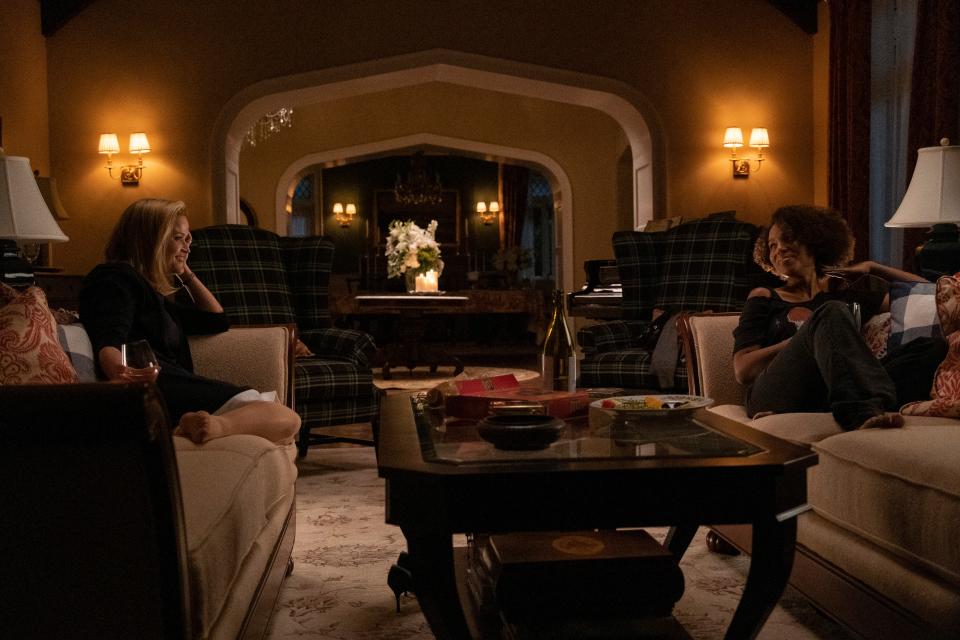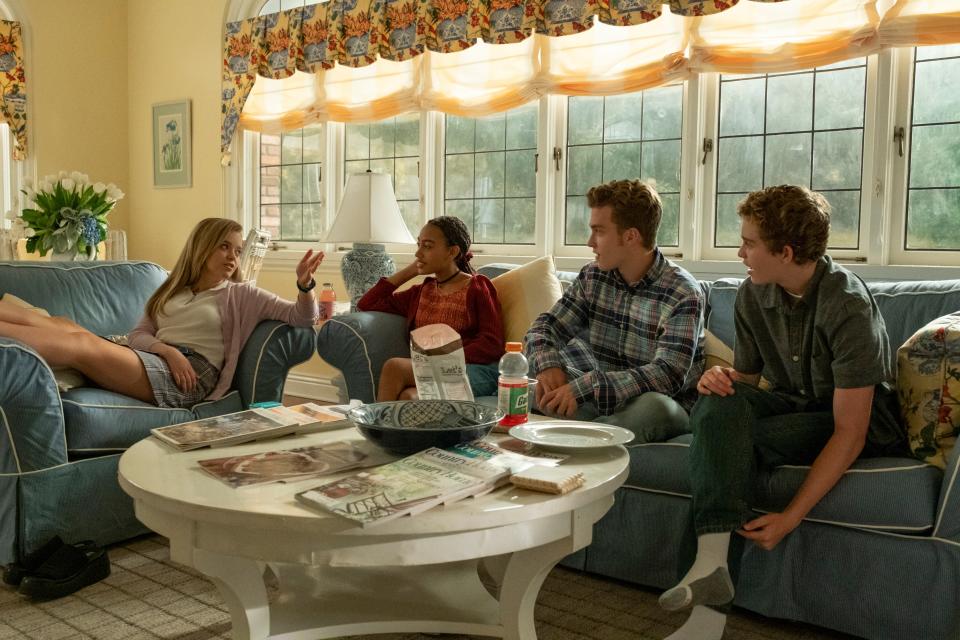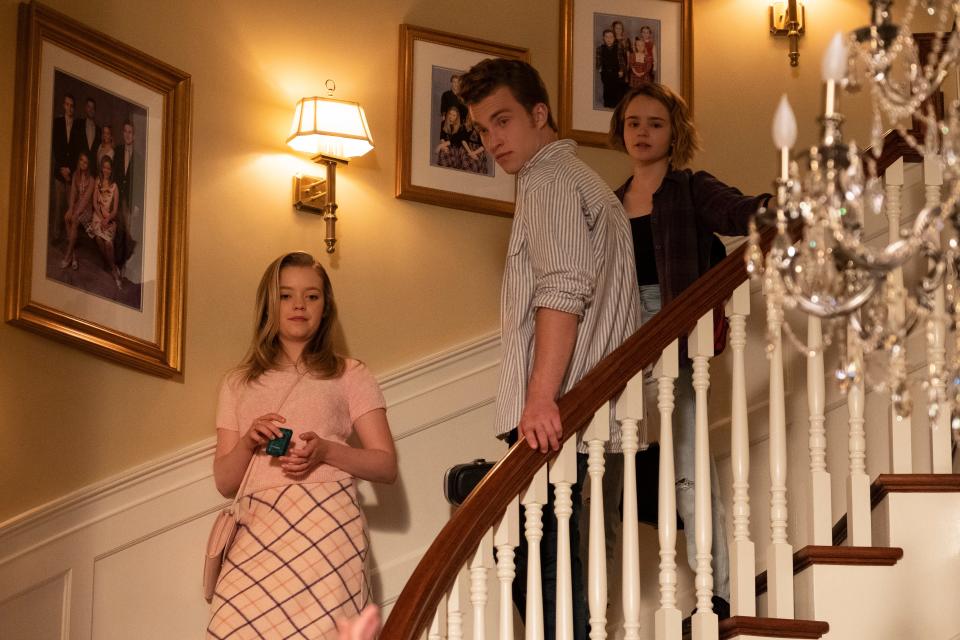Re-creating ’90s Suburbia for Little Fires Everywhere
For Little Fires Everywhere author Celeste Ng, visiting the set of her novel turned Hulu series was a walk back in time. Production designer Jessica Kender gave the best-selling writer a tour of the sets she created in Los Angeles to stand in for tony Shaker Heights, Ohio, on the show, and was pleased that Ng recalled memories of her own teen years in the Cleveland suburb. “Celeste grew up there and had a very clear vision, so we didn’t veer too much from the book,” says Kender. “She walked through the house, and it was great to hear her talk about her friends from Shaker Heights High School.” Leaving no stone unturned, the designer says a Cleveland Indians pennant in particular sparked Ng to reminisce.
The eight-episode series Little Fires Everywhere, which premieres March 18, is the tale of two devoted mothers and their families, whose lives are intertwined but not necessarily in a good way. Reese Witherspoon portrays Elena Richardson, the perfectionist matriarch of a wealthy Norman Rockwell–ian family with four children. Kerry Washington’s Mia Warren, who rents a duplex from Elena, is the restless and often homeless bohemian artist and mother of daughter Pearl.
The Richardson mansion plays an additional character that should receive top billing in the credits, so finding just the right setting was paramount. Kender and the film’s location manager scouted homes in the real Shaker Heights before returning to Los Angeles only to find the perfect house in Hancock Park. “We saw this big beautiful Tudor-esque house built in the 1920s. It was in this little pocket on top of a hill with a fountain in the middle. Everything about it read very old money, it has this beautifully moneyed perfection type of vibe,” she says of the house’s exterior (interiors were shot on the soundstage).

Seventy Cents
Research for Elena’s Type-A interiors began with a look at decor in the ’90s. “We stayed as close to the book as we could, and I pulled up all those aspirational catalogues. [These] people don’t believe they are rich; they believe they are comfortable, so we didn’t go super high end,” says the Midwest-born designer, who graduated from high school in the late ’90s. “At that time, Ethan Allen was aspirational.” Nineties-style Shaker Heights translated into an all-white kitchen with copper pots and marble countertops where much of the action takes place. Working with set decorator Lisa Clark, Kender created a living room with a massive fireplace, custom made of stone, that aids the narrative with the changing of the seasons. Elena, who would color-coordinate her four children’s lunch bags, also color-coded the books in her library. “Her character was all about control, so the items in the house were carefully chosen,” says Kender.

Seeds and All
Overscale furnishings straight out of Pottery Barn circa the 1990s were used for the den, while Roman shades and valences are also reminiscent of the period decor. To aid the plot points (no spoiler alerts here), Kender and Clark sourced accessories with an Asian influence such as Ming-vase-pattered fabric found at every fold of the curtain valence. For the color palette, Kender brought in “color of the time, such as forest green, yellow, and blue combinations, which we don’t see a lot of anymore.” For the master bedroom, the designers looked to another reference point from the ’90s, Laura Ashley. “We had a custom comforter made with two different patterns (on the top and bottom). The wallpaper matches the drapes, and we played off that.”

The Spark
Mia Warren’s duplex (a house in Pasadena) provides a contrast between the two characters. “Mia is more transient, and her house has a warm feel as they travel only with their clothes and her art supplies,” says Kender. “The character found furnishings at the thrift shop and turned the sunroom into her art studio. She found natural objects like branches [and] feathers, and hung a fishnet from floor to ceiling and her artwork on the painted accent walls.” The designer also took her cues from Washington, who, after a walk-through of the sets, would give various design notes. “Kerry did not want a lot of furniture in the bedroom as it would feel too permanent,” she says. “Her character’s space was a bed on the floor, a side table, and artwork above the bed. She didn’t even want incidental chairs to show that [her character] was staying.”
For the plot’s pivotal opening scene (spoiler alert!) when Elena’s house burns down, the design team tackled the challenge with a full-scale fire of the house on the studio burn stage, and then created a metal framework a third of the size of the house aided by special effects. Sourcing the period that was just two decades ago proved to be a challenge for the designers. “The ’90s is not a hip decade right now, so finding sources was hard. We did a nationwide search on eBay, and we also looked at Craigslist and Calico Corners for fabrics,” says Kender. “We wanted to hit the period beats of the ’90s.”

The Spark
The design, like the story, is essentially a tale of two women, one who is trying to be very hip and current and the other whose life is reflected in items from the thrift shop. “To be honest, it was one of the best scripts I have ever read, and the characters are so well written that you know who they are,” says the designer. “The characters are so strong, and we really wanted to get it right.”
Originally Appeared on Architectural Digest

